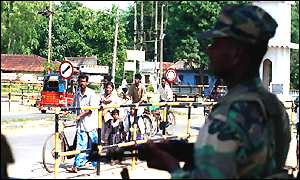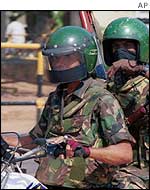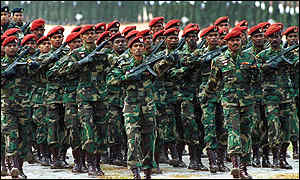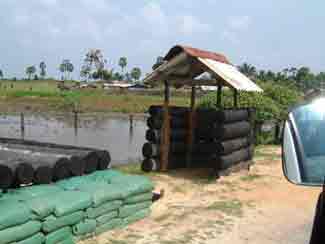| Normalization & an army of occupation | |||
|
There has been some surprise expressed at the disenchantment of the Tamils with the ground situation in the Northeast on the first anniversary of the Ceasefire Agreement. While there were celebrations in the South on February 22, there were protests in the Tamil areas. Why this discrepancy? Are the Tamils never satisfied? "What do the Tamils want?" There have been some significant benefits of the ceasefire in the Northeast. There have been almost no civilian deaths during this period. There has been no new displacement - in fact many people have returned to their place of origin. The threat of shelling and bombing and a battle on top of one’s home at any moment has been suspended. The blockade has been lifted and the movement of people and goods is considerably freer than it has been for years. The economy, particularly in agriculture, is showing the beginning signs of some resuscitation. Some government services, such as education, have shown some indication of being revived and NGOs have more latitude for programs. These are all welcome and a wonderful relief. ARMY OF OCCUPATION By this time, however, there were expectations that the Sri Lankan armed forces would be less of a daily presence in the Tamil areas. Even the army expected that "by Christmas [2002] we will have returned to barracks." This withdrawal from civilian space has not occurred. Most of the Tamil press uses language such as ‘the need for normalization’ and ‘the need for the withdrawal of the armed forces from public buildings in accordance with the Ceasefire Agreement’ to express the reality that the Sri Lankan armed forces continue to play a forward role in the public and private life of the Northeast. Remember that this army is composed of Sinhalese operating in areas that are predominantly Tamil.
Eight of the Sri Lankan army’s nine divisions are stationed in the Northeast. On the Jaffna peninsula there is one soldier for every 10 civilians. And they are not confined to High Security Zones or the borders of the army-controlled areas with the areas controlled by the LTTE. These soldiers are still a prominent and obvious presence on the roads, in the markets, in public buildings and intruding into the peoples’ private lives. There are still bunkers manned throughout the Jaffna peninsula. Both public buildings and private homes are still occupied by the army. Many public buildings, including schools and hospitals, have camps in close proximity. The Tamil paramilitaries in the pay of the Ministry of Defense have not been thoroughly disarmed. The army continues to go from home to home demanding an accounting of the inhabitants, especially new arrivals. Those who participate in public protests are intimidated and threatened. Who meets with whom and where is still carefully noted. The machinery of the counterinsurgency state remains firmly in place in the Northeast. Disappearances and obvious brutality are being held in check by the Sri Lanka Monitoring Mission, but that counterinsurgency machinery is well-oiled and ready to spring into action again at any moment.
The Sri Lanka Monitoring Mission gave a hint that they are beginning to realize the problems with this heavy military presence when, after the incident last month in Manipay, Jaffna, they called for the strengthening of the police to allow them to deal with civilian law and order issues instead of the army. J.S. Tissanayagam, in an article in the Feb. 21 issue of the Northeastern Herald, explained why this would not alleviate the problem. The Tamils’ recent historical experience is with Sinhalese policemen brought in by the central government to further their political project of intimidating the Tamils and no better for civilian well-being than the army. In fact the Special Task Force, which has terrorized the East since its formation in the 1980s, is actually a branch of militarized police.
What is called for instead is a police force beholden to local authority that derives its legitimacy from the local population rather than the central government. This, however, is the essence of autonomy, exactly what the army has been fighting against all these years. Some of these law and order issues will have to wait to be resolved until a final political settlement. However, an immediate end to the pervasive military presence in civilian areas and an immediate end to the oppressive and intrusive information gathering by the military would provide another step along the path toward a ‘normal’ situation in the Northeast. HIGH SECURITY ZONES A second cause for dissatisfaction on the one year anniversary of the Ceasefire Agreement is the amount of territory covered by High Security Zones not obviously required by military needs. When one looks at the map of Jaffna posted at the Tamil Guardian website, a good one quarter or more of the land area of the Jaffna peninsula has been designated High Security Zones and army camps are sprinkled all over, particularly along main roads. The area to the north of Jaffna City in Valigamam North, because it is one of the most fertile areas of the peninsula and because the population has been shut off from the coastline, is a particular subject of complaint. Army camps at civilian checkpoints and in close proximity to or surrounding civilian buildings are also a major problem in the East. Just recently the Navy declared a thousand acres of pastureland close to the Attavanaikulam tank as a High Security Zone General Nambiar, a retired Indian military officer, is soon expected to deliver a report on which areas of these High Security Zones are not of urgent military necessity. One hopes that, as the military threat should be gradually retreating and the military’s role in subjugating the population becomes less accepted, Gen. Nambiar will recommend that these military zones of occupation can be pared down to the bare minimum. FISHING A related issue to do with a continuing feeling of suffocation by military intrusion into civilian spheres is the restriction placed on fishing. A significant portion of the population derived its livelihood from fishing before the war and fish provided an important source of protein for the non-fishing remainder. Restrictions on times for fishing, areas for fishing and general harassment of fishermen by both the army and the navy has contributed to the feeling of unease felt in the Northeast. It is hoped that a general concern for civilian well-being will start to take precedence over military concerns.
The Northeast has essentially been under army occupation for two decades. This army has engaged in a counterinsurgency strategy of targeting civilians and civilian infrastructure to eradicate the base for political sympathies with which those in Colombo did not agree. The question now is - can the armed forces draw back from that role of intimidating civilians into quiescence? Can it allow a civilian space for action in the Northeast, even if the civilians express opinions the army does not like? Until civilians are able to take part in day-to-day life and to express whatever political opinion they wish - without the armed forces breathing down their necks - the situation in the Northeast will be far from ‘normal.’ A.S. March, 2003 |
|||




